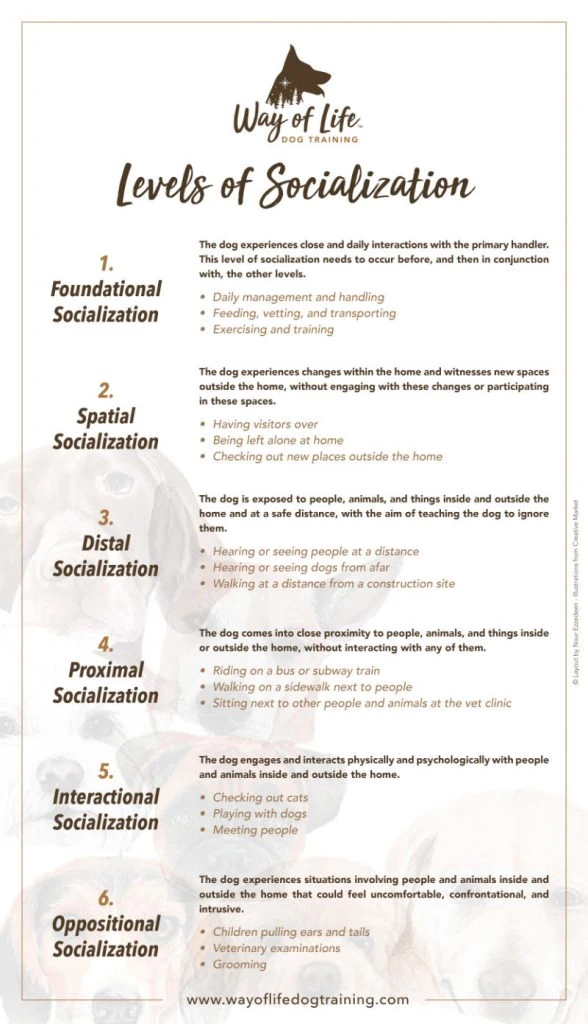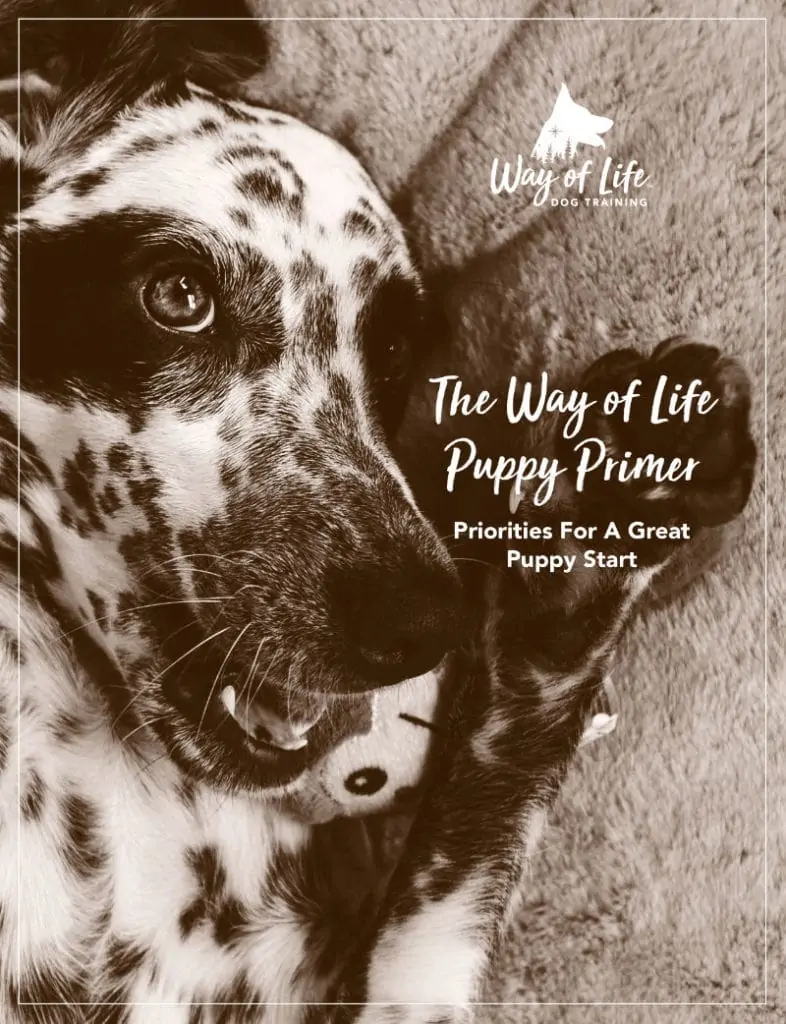With things going back to some kind of post-pandemic normal and many of us socializing again, I’ve been reflecting on this notion of “socialization” that obsesses so many dog trainers and owners.
There’s more to this important concept than meets the eye. For starters, we need a finer definition of what socialization actually means. As you’ll see in this season’s infographic, there are different kinds, categories, and degrees of socialization.
For some reason, however, socialization has come to mean exposing our new pups and dogs to excessive interactions with people and animals, often in their first few days, weeks, and months with us. All in the name of making them social and friendly. Many of the issues we deal with here at Way of Life™ can be traced to owners (through no fault of their own) having misunderstood what it means to socialize a dog.
One of the first things I ask clients whose dogs exhibit behavioural issues is to think back on those early days and write down all the different people, places, animals, and things to which they exposed their new dog. That list quickly shows clients how they may have overwhelmed the dog before they had much “relationship material,” as I like to call it, with their dog. These early experiences with socialization have produced concerns that now need addressing.
In this issue’s Reflecting on Our Bond, I invite readers to consider the potentially controversial notion that being “social” is not the most important thing to cultivate in dogs. There are other things to be nurtured before being social is even possible.
In Pro Tip, I argue that we need to mean something to our dog before we start socializing in the outside world. We need to be a source of safety first and have enough relationship material for social encounters to be experienced as safe and fun.
In Ask Way of Life™, I answer a question about the changes confronting many dogs, as owners return to the workplace. I explain that changes in way of life are an aspect of socialization. We should not fear change but instead prepare dogs to take it in stride. If the pandemic has shown us anything, it’s that change can and does happen, so we need to raise change-ready dogs.
I really hope that you find these different angles on socialization enriching and helpful!
Otherwise, we’ve been very busy here at WOLDT. Our first virtual class, To Raise a Dog, was immensely successful. I thank participants again for their enthusiasm and eagerness to learn more about the importance of way of life and doing things in stages.
We’ll be offering more classes in the future, so please stay tuned!
I’ll be back in touch soon. Until then, enjoy a wonderful summer, and be well!
Cheers,
~ Souha
This Season’s Infographic: Levels Of Socialization

Reflecting On Our Bond
In the world of dogs, we tend to emphasize the training of the dog as an animal, much more than the raising of the dog as a canine companion or family member. By emphasizing “training,” we’re generally working towards acquiring certain skills, such as sitting on command, politely waiting for a meal, walking nicely on a leash, and so on. Yet, it takes much more than skills-training to nurture the dog that we want.
In coaching clients and their dogs, I emphasize “rearing” over training. When we focus on rearing, the attention shifts from the dog learning something to the dog becoming something – a certain kind of animal, endowed with particular traits.
There are three such traits that I work to instill in dogs:
Soundness, strength, and spiritedness.
Sound
Before anything, I want my dogs to be sound. Sound dogs are thoughtful, calm, and balanced. Because they can think, they can discriminate between situations and understand that some behaviours are acceptable in some places but not others. Sound dogs are non-confrontational and non-reactive. Instead of succumbing to the fight-or-flight response, they seek out their person should any doubt or stress arise in their minds.
Strong
A life with humans in the 21st century is not exactly easy on dogs. Cultivating their strength helps build resilience against many common stressors, including everything from fireworks, thunderstorms, traffic and construction noises, our long working hours in and outside the home, and dealing with a public that feels entitled to invade their personal space.
Spirited
Having bestowed upon my dogs the gifts of being able to think (soundness) and deal with life (strength), I’ve now instilled confidence and spirit in them. The dogs aren’t afraid to be who they are. They can “be dogs” in all the exquisite ways this manifests, including being goofy, pushing boundaries, and unashamedly expressing joy. Basically, being vulnerable.
Notice I didn’t say “friendly.” I didn’t say “social.” I didn’t even say “polite” or “obedient.” Simply stated, without a foundation of soundness, strength, and spirit, none of the things we might legitimately want in a dog can be developed.
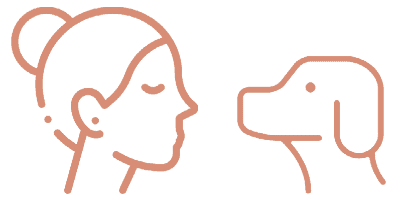
Pro Tip
Foundational Socialization
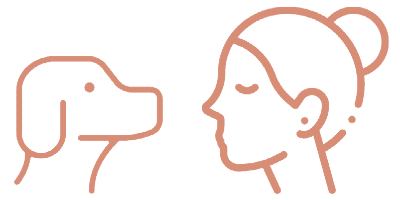
Socialization is not an all-or-nothing thing. There are types and degrees of socialization, all important for the growth and maturation of the dog (see infographic).
However, it’s crucial to remember that there needs to be a healthy relationship foundation between human and dog before we socialize in the traditional sense of the word. This is what I call foundational socialization.
When we have a healthy relationship foundation, dogs trust that the people, animals, and things to which they’re being exposed are safe. When we have a budding bond with our dogs, i.e. relationship material, they understandably become more open to the challenges and experiences we’re showing them.
This foundational socialization and temporary delaying of the other levels of socialization minimize the likelihood of the dog having negative reactions to things. Premature exposure to things can result in negative reactions, not because those things are inherently negative to the dog, but simply because the dog does not yet trust the humans showing the dog those things.
That’s why it’s essential we keep it simple at the start. It’s why I keep going back to foundations and the decompression that takes place in those early days, weeks, and months. This allows for that one-on-one interaction and foundational socialization to happen, without competing sources of attention. If you forged ahead with socializing your dog with insufficient foundations and you can see now how excessive this all was, you can definitely go back to foundational socialization and work your way back up.
My clients often ask how long this stage lasts. The answer is that it depends on a host of factors – the dog and its background, the current home and family situation, and I would say especially the attitude of the handlers. Dogs come around faster and begin to show readiness for more when the humans are detached and not in a hurry. Still, it takes time to build healthy foundations so let’s not rush.
One last thing to note is that people are not necessarily going to understand the approach you’re taking. You might face some opposition, or even outright criticism. At best, expect some bewilderment bordering on guilt-tripping as to why you’re not out there socializing your pup with everything under the sun. Be prepared and stand your ground without necessarily entering into philosophical debates. Time will tell the tale. Your dog will ultimately show that you did the job right.
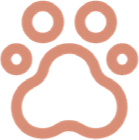
“I might be tempted to socialize more if the conversations taking place around me were half as interesting as the dialogue going on inside my head.”
~ Richelle E. Goodrich
(American novelist and poet)
Slaying Dragons: Quotes, Poetry, & a Few Short Stories for Every Day of the Year
Ask Way of Life™ Dog Training
Q: After more than two years of working from home, we’re back at the office on a part-time basis. We’ve had our dog since before the pandemic, but she’s hardly been left alone all this time. We know she doesn’t suffer from separation anxiety, but we still feel bad because it’ll be a change for her. Is there a way to make this easier on all of us?
A: Great question and surely a concern for many others who are returning to the office, some to “hybrid” work arrangements and others to regular pre-pandemic schedules. It’s great to hear that your dog doesn’t suffer from separation anxiety, and your concern with how she will adapt to the change is legit.
In this season’s infographic, you’ll see that one level of socialization is “spatial.” This means that a change in the space, context, situation, or environment is a form of socialization and part of raising dogs and preparing them well for life.
A change in situation is stressful, surely, but also an opportunity to mature our dogs. Fluctuations in our human lives are inevitable and it’s our job to raise dogs that are sound, strong, and spirited enough to handle change. Here’s the thing though: we need to be the ones modelling a positive attitude around change. I know that many people are themselves stressed about leaving their animals behind, not realizing how much that feeds the animals’ anxiety.
Of course, there will be a period of adjustment for all involved but our attitude can make all the difference. Here are three reasons why your part-time return to the office is a good thing:
- Being away from home for some time is good for you. Yes, we might dread having to dress for work, commute, and get into our work selves. But ultimately, it’s good for us to step into a different space for a few hours, partake in our own kind of socialization, and come home ready for some canine quality time.
- Being away from home for some time is good for your dog. I’ll say this another way: Being alone is good for your dog. I never want to go back to how much time we spent away from our dogs pre-pandemic, but it’s good for them on many levels to be left alone for some of the time (more on that later!).
- Riding out changes such as this one is a good thing. Again, remember that changes in way of life constitute exercises in socialization. They are part of the experiences of rearing our dogs successfully. When we ride out changes calmly and confidently, dogs mature and our bonds deepen.
Above and beyond thinking about this change a little differently, there are many things you can do to facilitate the transition. One of the reasons that I’m such a proponent of crating dogs is precisely because it teaches them to be by themselves. I also coach my clients on making a habit of leaving their dogs alone for varying amounts of time. As well, the common advice of not making a big deal out of leaving or coming back is especially applicable if the dog is not entirely comfortable being alone just yet and/or has a more sensitive and clingy disposition. I also coach clients with multiple dogs in regularly taking some and leaving others behind.
Pandemic aside, the more consistent we’ve been with making separation and alone time facts of life, the easier the transition will be. While most dogs will adjust fine, some will likely exhibit separation anxiety and added measures will need to be taken. Please see the note below for a past feature on separation anxiety and stay tuned for more on this subject.
The issue of leaving dogs alone is an important one. Indeed, it’s a moral and ethical matter, and one significant enough to deserve further discussion down the road. One of the silver linings of the pandemic is that it has demonstrated much office work can be done remotely, and that our animals do not have to, and should not have to, be left alone for as much as they once were.
With that said, teaching our dogs to be alone confidently is good for them. In fact, it’s one of the best things we can do for their soundness, strength, and spiritedness. Please don’t hesitate to reach out to us with any concerns about the changes in your way of life post-pandemic and beyond!

Thank you for your excellent questions – please keep them coming!
Note
Check out the Winter 2020 Newsletter for a previous Q&A on separation anxiety:
“Will my dog develop separation anxiety when the pandemic settles and we go back to the office?”
https://wayoflifedogtraining.com/seasons-greetings-2020/
Seasonal Suggestions
KLIMB® Dog Training Platform by Blue-9 Pet Products
I’d initially balked at the price tag of the Blue-9 KLIMB® training platform, which retails in Canada for almost $500. Yet I kept hearing of the many awards it garnered, saw an excellent video of a trainer using it, and decided to give it a try. I liked it so much I ordered a second one.
Dog owners use platforms like these in many different ways – for play, rest, training, and fitness. The KLIMB® can be an excellent tool for physical conditioning, especially when used with the Blue-9’s Propel Air PlatformTM. As a training tool, it can be used to teach dogs to go to their “place” and to “wait” or “stay” on these platforms, with varying degrees of duration, distance, and distraction.
As someone with a busy schedule and multiple dogs, I’ll play with some while the others wait their turn on the platform, aided by its spacious and sturdy design. (Tip: I recommend adding the nonslip traction mat.)
The product is light and the legs can be easily unscrewed and tucked into the back of the platform for easy storage and transport. The design also allows for stacking and connecting multiple platforms together.
In short, I highly recommend it! I see it as a quality product that can serve you in different ways for a long time.
To find out more about using the KLIMB®, check out the Blue-9 Pet Products YouTube channel:
Himalayan Salt/Yak Chews
We all know how much dogs like to chew and how physically and mentally satisfying it is. Providing dogs with chewing opportunities helps ease all sorts of behavioural issues and keeps them occupied when we’re a little busy or in need of some respite.
There are also different kinds of things that dogs can chew on, from filled up Kongs to bully sticks and dental chews. Yak chews, or Himalayan salt chews, are one of my favourites for my crew. They’re called Yak chews because they’re made by boiling yak and cow milk and drying the milk until it hardens. It’s an entirely natural product that’s considered more digestible than bones or antlers, and rich in protein with decent amounts of omega-3 and calcium.
For those of you with tough chewers, this hard chew is long-lasting and quite challenging for dogs. Dogs must work at softening the hardened milk before they’re able to bite off and chew little pieces.
A few tips to keep in mind:
- These chews can go bad if not consumed within a reasonable amount of time. I tend to keep my bulk orders in the fridge.
- Salt contributes to water retention so don’t be surprised if your dogs drink a lot while chewing or after. Just make sure you let them out for pee breaks accordingly.
- The dogs will work down the chew to a size that could constitute a choking hazard. Don’t throw it away; simply microwave it for a minute or two and let it cool. The bit will puff into a brittle, safe and easy to consume treat.
To make your own Yak chews, check out this recipe:
https://www.youtube.com/watch?v=F2Cr-wPvREc
Retailers in Canada
Nature’s Own Dog Chews: https://www.naturesowndogchews.com
Bulk Bullys:
https://bulkbullys.ca
Bully Bunches:
https://bullybunches.ca
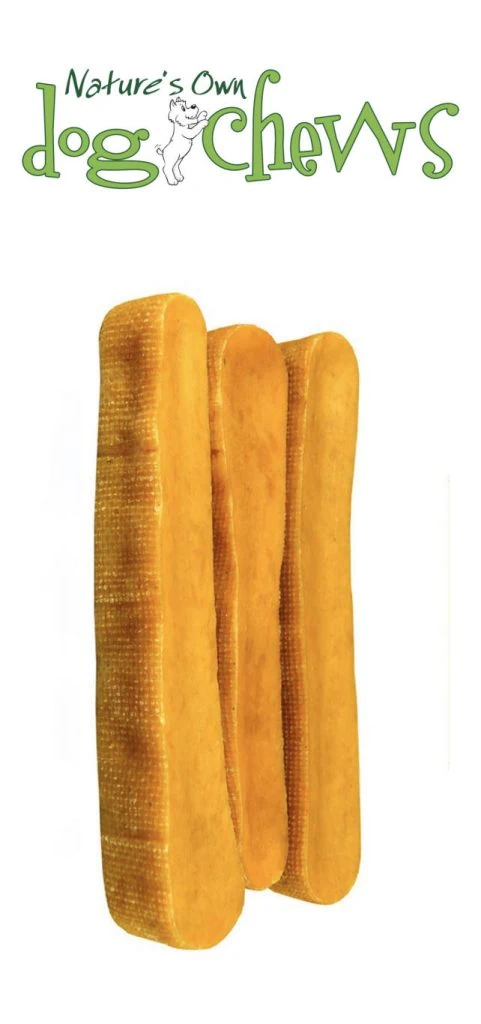
To make your own Yak chews, check out this recipe:
https://www.youtube.com/watch?v=F2Cr-wPvREc
Retailers in Canada
Nature’s Own Dog Chews: https://www.naturesowndogchews.com
Bulk Bullys:
https://bulkbullys.ca
Bully Bunches:
https://bullybunches.ca
Dr. Sasan Haghighat (Hyatt)
The Holistic Vet, Newmarket, ON
Dr. Sasan Haghighat (Hyatt), known by many of his patients as simply “Dr. Sasan,” is one of the most knowledgeable veterinarians I know and one of the most passionate and walk-the-walk people I’ve encountered in my career as a dog owner.
Dr. Sasan passed his licensing exams in Ontario in 2003, after graduating from vet school, garnering additional training in Germany and working at the Newmarket SPCA and the VEC in Toronto.
Dr. Sasan’s propensity for natural healing methods runs in his family, which in combination with his veterinary training, led him towards a mission of promoting healing from the inside out. Using food, herbs, acupuncture, chiropractic, and other modalities, Dr. Sasan firmly believes that as long as there is no immediate medical risk, gentler holistic approaches should be used whenever possible, even if they require a little more time to take effect.
While it was the late Dr. Sharon Kopinak who introduced me to holistic and naturopathic approaches to veterinary medicine, it was with Dr. Sasan that I really got to experience the effectiveness of acupuncture and biopuncture. Almost a decade ago, Dr. Sasan made all the difference in my dog Maya’s mobility and comfort despite a severe case of spinal compression. He helped us avoid a costly and extremely invasive surgery as well as minimize the use of pain medications. More recently, Kizzy experienced a severe episode of itching. Again, Dr. Sasan’s biopuncture treatment gave her instant comfort. A combination of baths, herbal tinctures, and supplements added to her diet eventually helped eliminate the itch. Kizzy’s skin has never looked or felt better.
If a holistic approach to healthcare interests you, don’t wait to check out the many success stories on The Holistic Vet website and book an appointment.
Heads’ up: There’s a waiting list of several months.
Find out more about Maya’s successful treatments with Dr. Sasan here:
https://holistic-vet.ca/maya-spinal-compression-torn-cruciate/
The Holistic Vet
987 Davis Drive East
Newmarket, ON L3Y 2R7
(905) 830-1030
petsbewell@holistic-vet.ca
Paws For the Camera
Introducing Taco the Chihuahua Cross, pictured here at approximately 12 weeks, soaking up the Southern California sun.
My client, a fiery young lawyer, happened to be in Baja California, Mexico, enjoying a few hours at the beach and the best tacos in the world. Normally, she went back home to LA with a local souvenir, such as a blanket or a piece of pottery. Little did she know that this time, it would be a puppy.
Heading back to her car after a copious serving of tacos, she came upon a tiny, all-black male pup with a little white on his chest. One of the locals told her he’d been orphaned and was “chihuahua chiquito” – not much bigger than a Chihuahua. My client instantly decided that she’d be taking him and named him Taco.

California, USA
We began working together remotely, and I must say she’s done an outstanding job with her pup, whose adventures you can follow on the Way of Life Facebook page. She’s worked on his training and his diet, and he’s been developing beautifully, despite unfavourable beginnings. This only strengthens my enduring belief in the power of “way of life.”
Taco and my client are visiting the GTA this summer and it’ll be our first time working together in person. I’ll be sure to keep y’all posted and in the meantime, hasta luego!
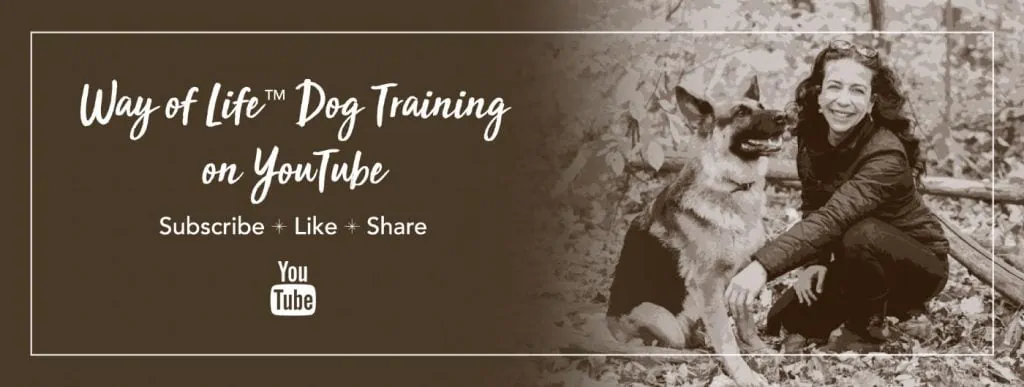
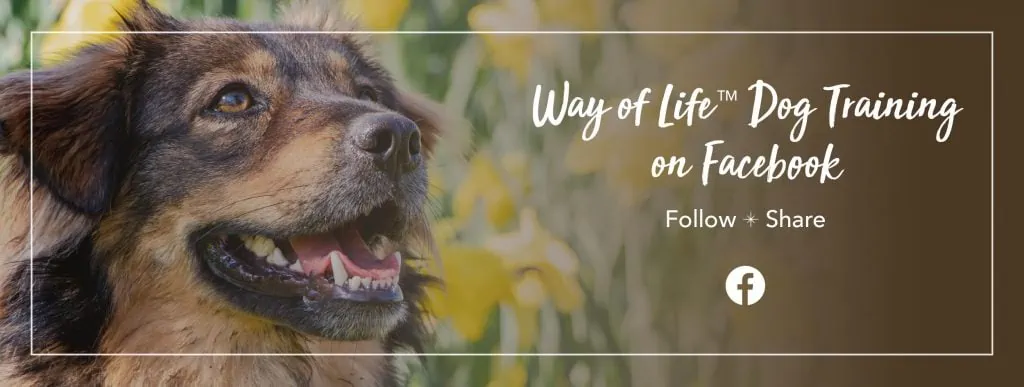
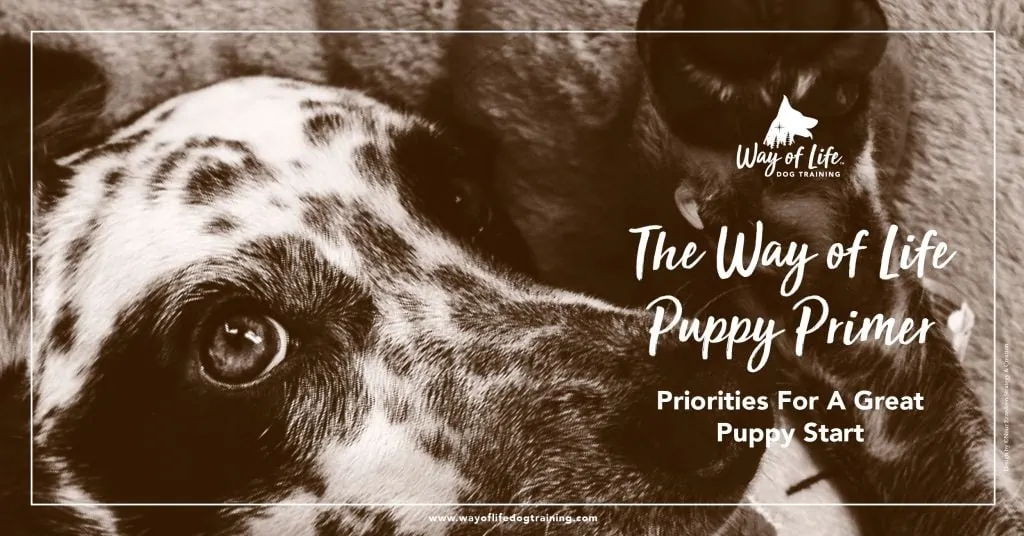
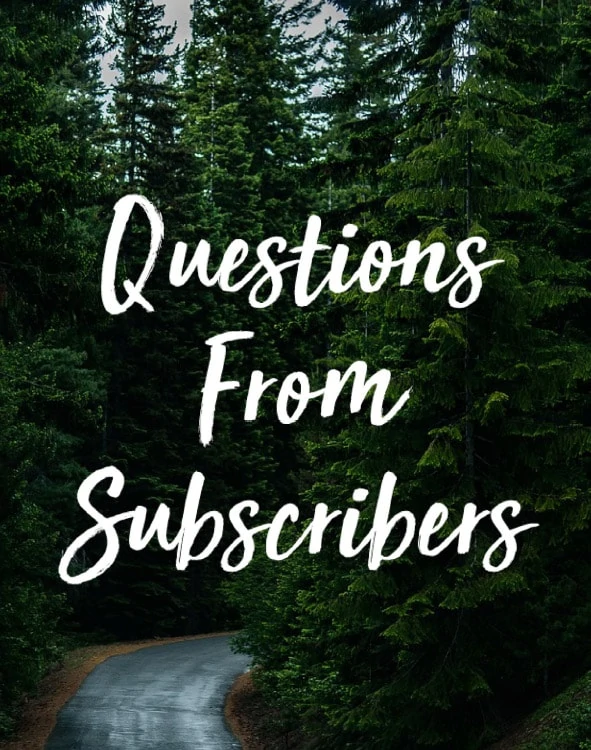
Is there a topic that you’d like me to cover in an upcoming newsletter or Facebook post? Please don’t hesitate to email suggestions or questions to info@wayoflifedogtraining.com.
Do you want to know more about transforming your relationship with your dog? Way of Life™ Dog Training is here to help.


